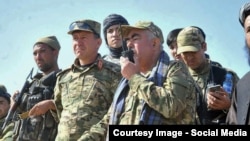
The actions of less than 1 percent of Central Asians are giving the entire region an odious reputation as a prime recruiting ground for Islamic extremist groups. In Syria and Iraq, for example, there have been reports and videos of Kazakhs, Kyrgyz, Tajiks, Turkmen, and Uzbeks who have joined some extremist group there.
Of all the peoples living in Central Asia today, Uzbeks are the most likely to be reported in militant groups from Afghanistan and Pakistan to Syria and Yemen. There are at least several explanations for why this is true, the most obvious being they are the largest ethnic group in Central Asia.
The most notorious Central Asian militant group to date is the Islamic Movement of Uzbekistan (IMU), which has resurfaced in the news recently, but there are also Uzbeks in the ranks of Al-Qaeda and the extremist group Islamic State (IS).
RFE/RL's Uzbek Service, known locally as Ozodlik, has been looking into the current state of Uzbek militants and uncovered some interesting details about them.
We'll start with the IMU. The IMU was thought to have ceased to exist as of the end of 2015.
Its most recent leader, Usman Ghazi, declared an oath of allegiance to IS in the summer of 2015 and late last year led a large group of his fighters from their sanctuary in Pakistan's tribal region to the Zabul Province in southeastern Afghanistan to join a Taliban splinter group under Mansur Dadullah that was loyal to IS. The traditional Taliban of then-leader Mullah Mansur joined with local ethnic Hazara forces that had suffered at the hands of the IMU, and together they annihilated the IMU in battles in late October and early November.
Nearly all the approximately 200 fighters, including Ghazi, were killed.
IMU fighters in northeastern Afghanistan came under Tajik leadership -- a group called either Jamaat Ansarullah or Jundallah. Those in northwestern Afghanistan appear to have been largely absorbed by local Taliban groups.
IMU Reforming?
But on June 6, a statement purportedly from the IMU was released. The statement mentions Ghazi's announcement that the IMU was joining IS but later refers to many "scholars" who said IS leader "Abu Bakr Baghdadi is not a caliph of Muslims but only an Ameer [Emir] of the 'Islamic State' group."
The statement says "the activities of the Islamic Movement of Uzbekistan did not stop," admits that its fighters were "dispersed in many faraway fields" and then later states the IMU will "stand shoulder-to-shoulder with… Muslim brothers of Afghanistan."
Ozodlik spoke with people who said the IMU was reforming under the leadership of former IMU leader Tohir Yuldash's son in the Fayzabad area in northeastern Afghanistan's Badakhshan Province. Tohir Yuldash was killed in a drone strike in Pakistan's tribal area in August 2009.
Ozodlik spoke to someone close to Uzbekistan's Interior Ministry. Under condition of anonymity, this person said the number of IMU fighters in northern Afghanistan was likely somewhere between 60 and 100, far lower than figures given by officials in Central Asia, Afghanistan, or Russia.
Asked why the Uzbek government claims there are hundreds of IMU fighters in northern Afghanistan, the source said, "To get money." They told Ozodlik that mid-level security officials in the border area know the real IMU numbers but report higher figures to keep their departments open, and people employed.
Clearly, authorities in Tashkent are still concerned about events in northern Afghanistan. RFE/RL's Gandhara website recently reported Uzbek security forces were conducting cross-border raids into Afghanistan, sometimes capturing Afghans and taking them back to Uzbekistan.
High Casualty Rate
Further away, Uzbeks are taking part in fighting in Syria and Iraq. Ozodlik contacted sources in Uzbekistan, Turkey, and Russia to get information about those groups of Uzbeks.
The vast majority of Uzbek militants in the Middle East are in Syria and most of those are in or near Raqqa. It has been reported that some are in IS but others are in extremist groups fighting against IS. Their numbers are nearly impossible to estimate, likely hundreds, possibly more than 1,000. They suffer a high casualty rate, which makes guesses at counting them even more difficult.
Some are veteran fighters from the IMU but most are not. They were recruited among migrant laborers in Russia and Turkey [See Noah Tucker's work on the Registan website] and most of these, according to Ozodlik's sources, are Uzbeks from Kyrgyzstan.
Ozodlik spoke with people involved in or familiar with recruitment efforts for extremist groups in Syria or Iraq. These "recruiters," or perhaps human traffickers would be a more appropriate term, are paid up to $10,000 for sending Uzbeks without military experience to extremist groups in the Middle East.An IMU veteran on the other hand, can be worth $30,000 or more to the person who successfully recruits and delivers such an experienced fighter.
So Uzbek militants are out there but their numbers are small. Depictions in some media give the idea that there are many thousands of them but a more sober estimate would be somewhere around 2,000 spread out from the Arabian Peninsula to Pakistan's tribal region.
Among the other Central Asian peoples, the number is even smaller.
That is something worth considering when assessing security aid to the Central Asian governments, particularly to the Uzbek government.








